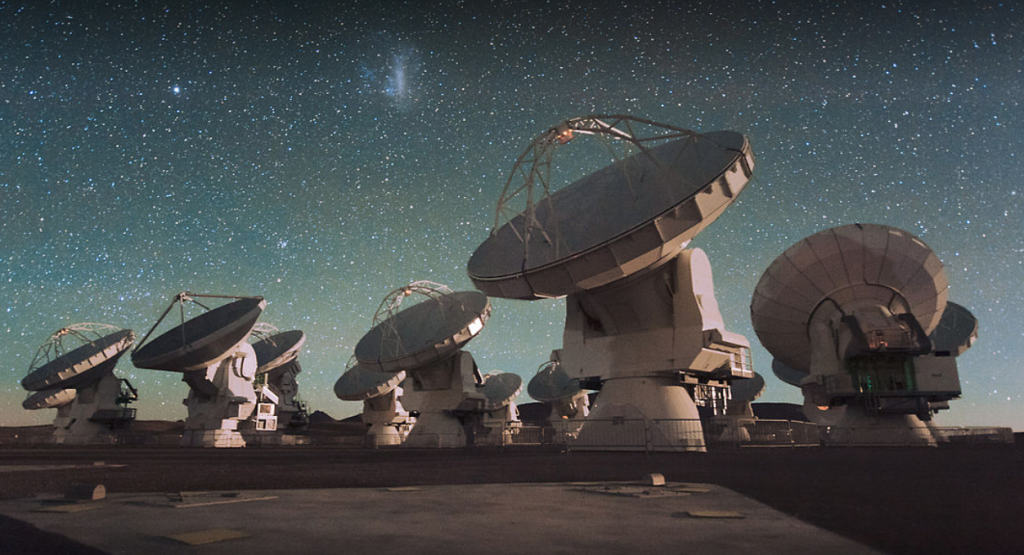Share This
Related Posts
Tags
IoT Phone Home
By Cutright Elizabeth on Jul 31, 2017 in Technology
As the Internet of Things expands exponentially, astronomers and tech companies are fighting it out in the newly crowded radio spectrum.
are fighting it out in the newly crowded radio spectrum.
In the high desert of northern Chile, the Atacama Large Millimeter Array (ALMA) scans the night sky, its 66 high-precision antennas seeking out the faintest radio waves. Unfortunately, the frequencies ALMA depends on to gather valuable scientific data exist on a previously unallocated radio spectrum suddenly crowded by competing interests, including all those smart devices scattered throughout our homes.
“There are no spectrum bottlenecks for dedicated Internet of Things systems yet,” Kevin Ashton, co-founder and former executive director of Massachusetts Institute of Technology’s Auto-ID Center, told Bloomberg BNA, “but we are seeing Wi-Fi services get maxed out, as there are only so many channels you can cram into the available spectrum.”
“The extent to which the Internet of Things will be a threat to radio astronomy will depend upon whether the regulatory standards can be upheld in the face of the massive onslaught of lawyers funded by the private sector,” Carla Beaudet, RF Test & Measurement Engineer at National Radio Astronomy Observatory explains to Discover Magazine. “If the regulatory standards are upheld rather than modified every time somebody needs more spectrum, there will still be small windows of spectrum in which astronomers can observe.”
Smart Spectrum
Every smart device, from temperature savvy toasters to programmable thermostats, communicates via radio waves. Unfortunately, as the number of wired gadgets and intelligent contraptions multiplies, previously unobstructed frequencies are jammed with the chatter of clever toothbrushes and talkative televisions.
While some bands are protected by the FCC – 1400 megahertz for hydrogen, for example – the rest of the spectrum gets shared by 29 services ranging from mobile phones to radio stations to military drones. As each slice of the frequency pie gets chopped into smaller and smaller pieces, those gigahertz become more valuable – prompting many companies to cast a greedy eye towards previously protected bandwidths.
“With soaring amounts of mobile traffic and an explosion in IoT devices (Cisco projects that, by 2020, there will be more than 50 billion connected devices in circulation around the world), existing unlicensed bands are becoming congested,” warned Slate’s Emily Hong last year.
“If these unlicensed bands become exhausted, future innovations might literally be crowded out.”
Allocating Frequencies
The National Academy of Science’s Committee on Radio Frequencies (CORF) hopes establishing guidelines will help separate commercial interests from scientific endeavors. Among the suggestions is the creation of a new spectrum between 275-450 gigahertz – a range that’s currently only used sparingly – but which, unfortunately, is the exact bandwidth used by ALMA. The situation in the Atacama highlights the growing conflict between private companies and academia.
As CORF leader Liese vanZee tells Wired, “It’s really tempting for the science community to put their foot down and say, ‘No no no,’” she says. “But, in fact, we do want to work with industry.”
The Spectrum Collaboration Challenge
For the powers that be at DARPA, allocating frequencies is an old model they’d like to see retired. In its place, they envision a Wild West version of the spectrum, with device creators empowered to choose whatever range works best – even if that means switching between frequencies to find the right fit. In fact, this December, thirty teams chosen at the beginning of the year will participate in DARPA’s first Spectrum Collaboration Challenge, battling it out to lay claim to the bandwidth they covet.
“If we want to eliminate the inefficiencies that exist today, we want to manage the spectrum at machine speeds, not people speeds,” Paul Tilghman, head of the challenge, told Wired.
For vanZee, the evolving demands placed on the world’s radio frequencies requires intelligent management. Filling up the airwaves with IoT prattle will drown out the whispers of the cosmos, making it that much harder for scientists to discover the mysteries that lie beyond our night sky.
“If you fill the spectrum with man-made emissions,” vanZee warns, “you will never be able to understand certain parts of the universe.”
